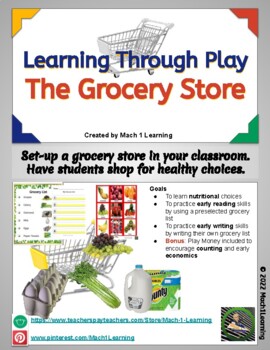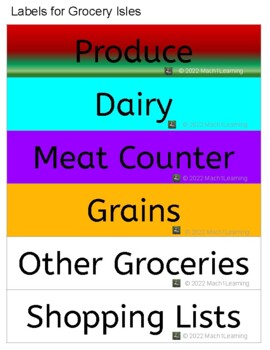Dramatic Play - Grocery Store Items - Math through Play - Centers
Mach 1 Learning
19 Followers
Grade Levels
PreK - 6th
Subjects
Resource Type
Standards
CCSSK.CC.B.4
CCSSK.CC.B.4a
CCSSK.NBT.A.1
CCSS2.NBT.A.1
CCSS2.NBT.B.9
Formats Included
- PDF
Pages
23 pages
Mach 1 Learning
19 Followers
Description
When children engage in real‐life and imaginary activities, play can challenge children’s thinking. Engaging your students through an imaginary grocery store leads to so many different learning experiences.
Included in this packet:
- 9 pictures of fruits color coded to the food pyramid
- 9 pictures of vegetables color coded to the food pyramid
- 9 pictures of grain group color coded to the food pyramid
- 9 pictures of dairy color coded to the food pyramid
- 9 pictures of protein color coded to the food pyramid
- 9 pictures of general groceries
- 9 preselected grocery list that selects 1 item from each group
- 1 grocery list for the sound /b/
- 1 grocery list for the sound /k/
- 1 grocery list for the sound /p/
- 2 student writing practice grocery list with dysgraphia modifications
- 12 one dollar bills
- 12 ten dollar bills
- Empty food pyramid
- Labels for storage or grocery isles
- 5 shopping carts that are color coded to the food pyramid
Total Pages
23 pages
Answer Key
N/A
Teaching Duration
N/A
Report this resource to TPT
Reported resources will be reviewed by our team. Report this resource to let us know if this resource violates TPT’s content guidelines.
Standards
to see state-specific standards (only available in the US).
CCSSK.CC.B.4
Understand the relationship between numbers and quantities; connect counting to cardinality.
CCSSK.CC.B.4a
When counting objects, say the number names in the standard order, pairing each object with one and only one number name and each number name with one and only one object.
CCSSK.NBT.A.1
Compose and decompose numbers from 11 to 19 into ten ones and some further ones, e.g., by using objects or drawings, and record each composition or decomposition by a drawing or equation (e.g., 18 = 10 + 8); understand that these numbers are composed of ten ones and one, two, three, four, five, six, seven, eight, or nine ones.
CCSS2.NBT.A.1
Understand that the three digits of a three-digit number represent amounts of hundreds, tens, and ones; e.g., 706 equals 7 hundreds, 0 tens, and 6 ones. Understand the following as special cases:
CCSS2.NBT.B.9
Explain why addition and subtraction strategies work, using place value and the properties of operations.





